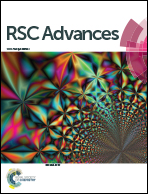In vivo drug release behavior and osseointegration of a doxorubicin-loaded tissue-engineered scaffold†
Abstract
Bone tissue-engineered scaffolds with therapeutic effects must meet the basic requirements as to support bone healing at the defect side and to release an effect drug within the therapeutic window. Here, a rapid prototyped PCL scaffold embedded with a chitosan/nanoclay/β-tricalcium phosphate composite (DESCLAYMR) loaded with the chemotherapeutic drug doxorubicin (DESCLAYMR_DOX) is proposed as a potential multifunctional medical application for patients who undergo bone tumor resection. We showed the DESCLAYMR_DOX scaffold released DOX locally in a sustained manner in mice without significantly increasing the plasma DOX concentrations. The evaluation of osseointegration in a porcine study showed increased mineralized bone formation, unmineralized collagen fibers and significantly higher alpha Smooth Muscle Actin (α-SMA) positive areas relative to the total investigated area (TA) in defects treated solely with the DESCLAYMR scaffold than in the DESCLAYMR_DOX; and alkaline phosphatase activity, α-SMA/TA and bone formation were higher in the DESCLAYMR loaded with 100 μg per scaffold DOX (DOX_low) than with 400 μg per scaffold DOX (DOX_high). Our results suggest that the DESCLAYMR_DOX can be a viable candidate as a multifunctional medical application by delivering the chemotherapeutic agent to target remaining tumor cells and facilitate bone formation.


 Please wait while we load your content...
Please wait while we load your content...